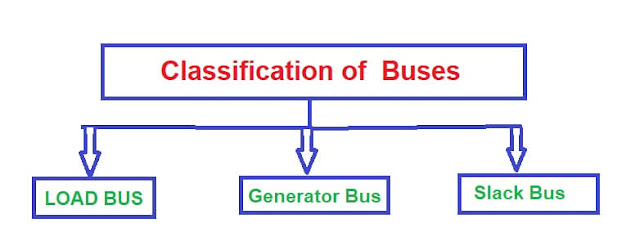Classification of power system Buses
In the power system, every bus is associated with four different quantities, real power, reactive power, bus voltage, and phase angle. In load flow, two parameters out of the four are specified and the remaining two need to be calculated through the solution of equations.
Depending upon the quantity that have been specified, buses in the power system are classified into the following three different types
In this article we are going to discuss power system buses/ load flow study, bus parameter, types of power system buses like load bus or PQ bus, generator bus, slack bus also known as swing bus and an explanation
Types of buses in power (flow) system studies:
 |
| Types of Buses in power system |
Load bus: PQ bus
load bus also called as PQ bus in this type of bus real and reactive components of power are specified and we need to find out the voltage magnitude and phase angle using load flow solution by solving equations using different methods.
The phase angle of voltage is not very important for the Load
Generator bus or voltage control bus:
Generation bus also called a voltage control bus. In this kind of bus voltage magnitude and real power are specified and required to find out reactive power generation Qg and phase angle of bus voltage.
Slack bus / swing bus or Reference Bus:
Slack bus is also known as swing bus this bus is taken as a reference bus. generally, in the power system, there are mainly two types of buses load bus and generator bus, for these buses real power P injection is specified. which is taken positive for generator bus and negative for load bus, the losses remain unknown till complete load flow solution.
For this reason, one generator bus is made to take the additional real and reactive power to supply losses in the transmission line, this type of bus is called a slack bus.
At this type of bus voltage magnitude and phase angle 𝛿 are known, where real and reactive powers are obtained through the load flow solution.
Below table show a comparison between different power system buses, known and unknown parameter of each:
| Bus Type | Known Parameter | Unknown Parameter |
| Load Bus | P, Q | V, phase angle |
| Generator Bus | P, V (magnitude) | Q, Voltage phase angle |
| Slack Bus | Voltage magnitude & phase angle | P, Q |